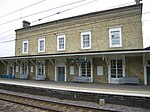Wellcome Sanger Institute
The Wellcome Sanger Institute, previously known as The Sanger Centre and Wellcome Trust Sanger Institute, is a non-profit British genomics and genetics research institute, primarily funded by the Wellcome Trust.It is located on the Wellcome Genome Campus by the village of Hinxton, outside Cambridge. It shares this location with the European Bioinformatics Institute. It was established in 1992 and named after double Nobel laureate Frederick Sanger. It was conceived as a large scale DNA sequencing centre to participate in the Human Genome Project, and went on to make the largest single contribution to the gold standard sequence of the human genome. From its inception the institute established and has maintained a policy of data sharing, and does much of its research in collaboration. Since 2000, the institute expanded its mission to understand "the role of genetics in health and disease". The institute now employs around 900 people and engages in five main areas of research: Cancer, Ageing and Somatic Mutation; Cellular Genetics; Human Genetics; Parasite and Microbes; and the Tree of Life.
Excerpt from the Wikipedia article Wellcome Sanger Institute (License: CC BY-SA 3.0, Authors).Wellcome Sanger Institute
London Road, South Cambridgeshire
Geographical coordinates (GPS) Address Nearby Places Show on map
Geographical coordinates (GPS)
| Latitude | Longitude |
|---|---|
| N 52.0775 ° | E 0.1875 ° |
Address
London Road
CB10 1SD South Cambridgeshire
England, United Kingdom
Open on Google Maps








